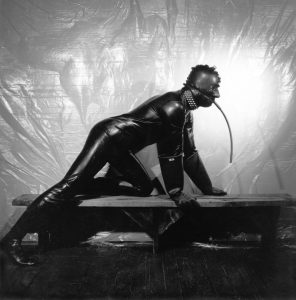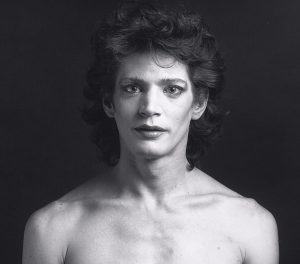
xuality and fetishism, igniting a culture war that rages to this day. More than 25 years later, the HBO Documentary Films presentation MAPPLETHORPE: LOOK AT THE PICTURES does just t
The film goes inside the preparations for a retrospective display as a jumping-off point to tell the complete story of his life and work for the first time, and explore the interplay between his personal and professional lives. The documentary reveals a controversial artist who turned contemporary photography into a fine art. Complete and unprecedented access to The Robert Mapplethorpe Foundation enables never-before-seen photographs and footage to be utilized to complete the picture as it were.
Expectations: I going into this documentary knowing next to nothing so I’m bound to learn something and possibly be shocked as well. From my perspective all I can tell you is that I knew Mapplethorpe was an artist who offended many with his photography work. I knew the subject matter was, however, of homosexuality and fetishism. Up until promos for this documentary I never even knew what the artist looked like or saw any of his work. So it should be a real eye opener to learn of his artistic expression and what made it so controversial. I will look at the pictures.
Gut Reaction: I enjoy the type of debate certain documentaries can raise within a viewer and for that reason I enjoyed MAPPLETHORPE: LOOK AT THE PICTURES. First, however, the film gives the viewer a clear picture of who the artist was, the lifestyle he led and the drive he had to be someone possessed with provocative power. As his own brother, Edward, mentions he was a guy who wanted to jolt people into feeling something about him and their surroundings. He did it not only with his demeanor but via his artistic expression. He did it via what was most comfortable to him and that was raw sexuality or rather homosexuality. But more than illustrating that the film gave me an opportunity to examine not our carnal knowledge but the debate of what defines art.
You cannot watch a biography of Mapplethorpe without looking at his photography portfolio. Yes, there are b/w portraits and still life photos, but his main focus was his nudes and more salacious imagery. Most of them did not offend me, but rather made me feel indifferent. Art is subjective and clearly others feel differently. Just as an example, is one of his most noted pieces (though it is the first time I ever saw it) entitled “Man in a Polyester Suit.” It shows a black man dressed in a fine business suit with the camera trained on his lower half to show us the male genitalia dangling out of the zippered fly. Yeah, men sport them in all kinds of shapes, colors and sizes, so what? But is it art? It is an expression telling us he finds such anatomy to be beautiful and wants you to react on the feelings of whether y
There is plenty to see here and good moments with those interviewed. There are good passages with Robert’s aforementioned brother as well as his sister and former lovers and models as well. It is not a wasted 109 minutes. I mean I am heterosexual and not into S&M and there were only two of three images I wished I could un-see; but, to each there own as they say.
Bonus: Here is an excerpt from an interview HBO posted with directors Fenton Bailey and Randy Barbato at a screening.
WHY THIS PROJECT?
Randy Barbato: Fenton and I lived in New York during the gay ’80s in the East Village, so we were aware of Mapplethorpe. But we were more aware of him as a brand, as a name, and obviously the controversy [the trial following his last exhibit]. We’re attracted to people who are overexposed and under revealed. And Mapplethorpe really ticked that box. Because we knew the name but we didn’t know the man or the artist, it was important for us to dig deep and represent him as an artist as much as possible and really try to pack the film with his work.
WHY NOW?
Fenton Bailey: Before he died he planned that exhibition, “The Perfect Moment,” and I think he knew exactly what impact it could have. But it would take a number of years before people could look at the pictures as he intended them too, as opposed to the way [former Senator] Jesse Helms and his supporters looked at the pictures.
As we were making it Randy and I felt, on the one hand, we’ve come a long way and it would be hard to imagine an exhibition showing explicit art resulting in a criminal trial. On the other hand, we feel that discussion about sex and sexuality and art feels as taboo as ever.
Randy Barbato: You can access pornographic images at the touch of your fingertips now, so we’ve become kind of sexually commodified as a culture, and yet Robert Mapplethorpe’s imagery still carries the same weight and impact. I think that’s because we as a culture are a split personality. We’re still as puritanical as we were back then; we’re sexualized but it’s all in the closet, and I think his intent carries the same power today as it did then even though the context of the times is completely different.

Robert Mapplethorpe self portrait
In Conclusion: In case anyone is wondering I conclude with the admission that I feel that the body of photographic work of Robert Mapplethorpe is art, some of it explicit art, but art nonetheless. It does not have to be art that any one person identifies with. A person won’t know if they identify with it, appreciate it, respect it, tolerate it or are offended by it until they look at it and make that call for themselves. I did and I don’t need to see it ever again but I can recognize it as art and that Mapplethorpe was an artist that dared convention.
Next: In a bit of catch up we will have an upcoming review of NOTHING LEFT UNSAID: GLORIA VANDERBILT AND ANDERSON COOPER.